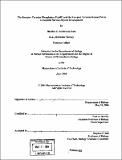| dc.contributor.advisor | Paul A. Garrity. | en_US |
| dc.contributor.author | Robertson Sears, Heather C., 1975- | en_US |
| dc.contributor.other | Massachusetts Institute of Technology. Dept. of Biology. | en_US |
| dc.date.accessioned | 2006-03-29T18:28:01Z | |
| dc.date.available | 2006-03-29T18:28:01Z | |
| dc.date.copyright | 2004 | en_US |
| dc.date.issued | 2004 | en_US |
| dc.identifier.uri | http://hdl.handle.net/1721.1/32254 | |
| dc.description | Thesis (Ph. D.)--Massachusetts Institute of Technology, Dept. of Biology, 2004. | en_US |
| dc.description | Includes bibliographical references. | en_US |
| dc.description.abstract | Cell migration and axon guidance are highly similar processes important for the development of the nervous system. Both processes involve the transduction of signals across the membrane, resulting in changes in the cytoskeleton. I have examined the roles of two receptors that are involved in axon guidance and cell migration in Drosophila. Ptp69D is a receptor tyrosine phosphatase required for axon guidance in the developing embryo and for layer-specific axon targeting in the developing visual system. Using a dominant-negative form of Ptp69D, I have identified several genes with which Ptp69D genetically interacts in photoreceptor axon targeting. Removing a single dose of the cytoplasmic tyrosine kinases Src64 or Abl or the repulsive axon guidance receptor robo enhanced the Ptp69D dominant-negative phenotype. In mammalian systems, Src plays a key role in the regulation of cell adhesion, and Abl is a known regulator of actin cytoskeletal dynamics. Removing a single dose of the EGF receptor or Ras85D suppressed the Ptp69D dominant negative phenotype. Interestingly, the cytoplasmic tyrosine kinase PR2 binds Ptp69D, and the C. elegans homolog of PR2 has been found to suppress the Egfr/Ras pathway. Other evidence suggests that the Egfr/Ras pathway may be required for axon outgrowth. In addition to PR2, I also identified the receptor tyrosine kinase Pvr in a biochemical screen for proteins that bind Ptp69D. I generated mutants in Pvr by gene disruption and EMS mutagenesis. These mutants have disruptions in the embryonic central nervous system, including mispositioning of axon tracts and the glia that wrap them. However, these defects are not inherent to the CNS. | en_US |
| dc.description.abstract | (cont.) Rather, they result from a failure of hemocytes to migrate out of the head and engulf dead cells in the CNS. To identify proteins that signal downstream of Pvr in cell migration, I used a yeast two-hybrid screen to identify 15 proteins that bind the intracellular domain of kinase-active Pvr. One of these proteins, drk, is required for Pvr-dependent Erk MAP kinase activation. None has defects in hemocyte migration when disrupted by RNA interference. Whether these proteins have redundant functions or function downstream of Pvr in other systems remains to be determined. | en_US |
| dc.description.statementofresponsibility | by Heather C. Robertson Sears. | en_US |
| dc.format.extent | 169 p. | en_US |
| dc.format.extent | 8658767 bytes | |
| dc.format.extent | 8655979 bytes | |
| dc.format.mimetype | application/pdf | |
| dc.format.mimetype | application/pdf | |
| dc.language.iso | eng | en_US |
| dc.publisher | Massachusetts Institute of Technology | en_US |
| dc.rights | M.I.T. theses are protected by copyright. They may be viewed from this source for any purpose, but reproduction or distribution in any format is prohibited without written permission. See provided URL for inquiries about permission. | en_US |
| dc.rights.uri | http://dspace.mit.edu/handle/1721.1/7582 | |
| dc.subject | Biology. | en_US |
| dc.title | The receptor tyrosine phosphatase Ptp69D and the receptor tyrosine kinase Pvr in Drosophila nervous system development | en_US |
| dc.type | Thesis | en_US |
| dc.description.degree | Ph.D. | en_US |
| dc.contributor.department | Massachusetts Institute of Technology. Department of Biology | |
| dc.identifier.oclc | 56023713 | en_US |
